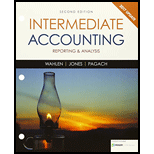
1.
Ascertain the transaction price per unit that is used to record the revenue.
1.
Explanation of Solution
Transaction price:
Transaction price is the amount of consideration that is estimated by the company to be authorized in exchange, for delivering the promised goods and services to the customer. Transaction price is examined by the seller by analyzing the terms of the contract and the normally conducts of the business.
$45 is the transaction price per unit since, sales of 1,800 units is expected and the price per unit with sales volume of 1,001-2,000 units is $45.
2.
Journalize entries to record the sakes made in the first and second quarters.
2.
Explanation of Solution
Contract:
Contract is an agreement among two parties or more parties which includes enforceable obligations and rights. A contract can be written, oral or implied by ordinary business practices.
Journal entry is a set of economic events which can be measured in monetary terms. These are recorded chronologically and systematically.
Accounting rules for Journal entries:
- To record increase balance of account: Debit assets, expenses, losses and credit liabilities, capital, revenue and gains.
- To record decrease balance of account: Credit assets, expenses, losses and debit liabilities, capital, revenue and gains.
Prepare journal entry for the first quarter:
| Date | Account title and explanation | Debit ($) | Credit ($) |
| Cash (1) | 40,000 | ||
| Sales revenue (2) | 36,000 | ||
| Return liability (3) | 4,000 | ||
| (To record the recognition of liability) |
Table (1)
- Cash is an asset and it is increased. Therefore, debit cash account by $40,000.
- Sales revenue is a component of
stockholders’ equity and it is increased. Therefore, credit sales revenue account by $36,000. - Return liability is increased. Therefore, credit returns liability account by $4,000.
Prepare journal entry for the second quarter:
| Date | Account title and explanation | Debit ($) | Credit ($) |
| Cash (Balancing figure) | 36,500 | ||
| Refund liability (3) | 4,000 | ||
| Sales revenue (4) | 40,500 | ||
| (To record the payment of refund) |
Table (2)
- Cash is an asset and it is increased. Therefore, debit cash account by $36,500.
- Refund liability is decreased. Therefore, debit returns liability account by $4,000.
- Sales revenue is a component of stockholders’ equity and it is increased. Therefore, credit sales revenue account by $40,500.
Working notes:
(1)Calculate the amount of cash during the first quarter:
Note: $50 is the price per unit for the sales of 0 to 1,000 units.
(2)Calculate the amount of sales revenue:
Note: $45 is the price per unit for the sales of 1,001 to 2,000 units.
(3)Calculate the amount of refund liability:
Note: $5 is the difference between
(4)Calculate the amount of sales revenue:
3.
Journalize entries to record the change in estimate.
3.
Explanation of Solution
Prepare journal entry:
| Date | Account title and explanation | Debit ($) | Credit ($) |
| Sales revenue (5) | 8,500 | ||
| Refund liability | 8,500 | ||
| ( To record the refund liability) |
Table (3)
- Sales revenue is a component of stockholders’ equity and it is decreased. Therefore, debit sales revenue account by $8,500.
- Refund liability is increased. Therefore, credit returns liability account by $8,500.
Working note:
(5)Calculate the amount of sales revenue:
Note: $5 is the difference between
Want to see more full solutions like this?
Chapter 17 Solutions
Bundle: Intermediate Accounting: Reporting and Analysis, 2017 Update, Loose-Leaf Version, 2nd + CengageNOWv2, 2 terms Printed Access Card
- Question 1arrow_forwardHorngren's Financial & Managerial Accounting: The Managerial Chapters, 8th Edition. Lily-Mae makes handheld calculators in two models: basic and professional. Lily-Mae estimated $812,500 of manufacturing overhead and 625,000 machine hours for the year. The basic model actually consumed 250,000 machine hours, and the professional model consumed 375,000 machine hours.Compute the predetermined overhead allocation rate using machine hours (MHr) as the allocation base. How much overhead is allocated to the basic model? To the professional model? Basic $325,000arrow_forward3. A corporation's working capital is calculated using which amounts? Total Assets And Total Liabilities Total Assets And Current Liabilities Current Assets And Current Liabilitiesarrow_forward
- The changes that occurred during a recent year in the accounts Retained Earnings and Treasury Stock will be presented in which financial statement? Balance Sheet Income Statement Statement Of Cash Flows Statement Of Comprehensive Income Statement Of Stockholders' Equityarrow_forwardThe amount spent for capital expenditures will be reported in which section of the statement of cash flows? Cash Provided/used In Financing Activities Cash Provided/used In Investing Activities Cash Provided/used In Operating Activities Supplemental Informationarrow_forwardWhich of the following will appear as a negative amount on a statement of cash flows that was prepared using the indirect method? A Decrease In Inventory An Increase In Accounts Payable An Increase In Accounts Receivable Depreciation Expensearrow_forward
- Which of the following will appear as a positive amount on a statement of cash flows that was prepared using the indirect method? An Increase In Accounts Receivable An Increase In Inventory A Decrease In Accounts Payable Depreciation Expensearrow_forwardWhat is usually presented first in the notes to the financial statements? Accumulated Other Comprehensive Income Commitments And Contingencies Significant Accounting Policiesarrow_forwardWhich is the annual report to the SEC that contains the financial statements of a publicly-traded corporation? Form 1040 Form 10-K Form 10-Q Schedule Carrow_forward
 Intermediate Accounting: Reporting And AnalysisAccountingISBN:9781337788281Author:James M. Wahlen, Jefferson P. Jones, Donald PagachPublisher:Cengage Learning
Intermediate Accounting: Reporting And AnalysisAccountingISBN:9781337788281Author:James M. Wahlen, Jefferson P. Jones, Donald PagachPublisher:Cengage Learning
